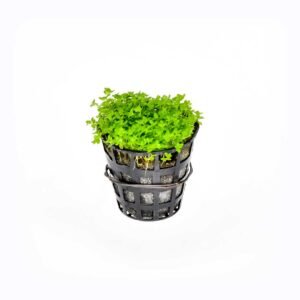Echinodorous Major

Echinodorous Major
#GWAE114
₹100 Original price was: ₹100.₹75Current price is: ₹75./-
Common Name: Ruffle Sword
Ruffle Sword plants have been a long-time staple for planted tank geeks. Their long, thick ruffle-textured leaves have beautiful striations that catch the eye, even in the back or mid-ground of your tank. Their bright green color makes an arresting contrast with red colored plants. They are easy to keep and a great option for beginners.
Ruffle sword plants can grow rather huge, so they need to be pruned regularly. They can be great plants for large size tanks and will grow either submersed or emersed. In their native habitat of Central and South America, they are typically found growing submersed along river banks and streams. With a nutrient rich substrate these plants will tolerate most lighting conditions, but moderate to high lighting is ideal. CO2 injection is not necessary but will help the plant grow faster.
Ruffle sword plants propagate through side shoots off of their leaves, which can be trimmed and replanted into the substrate. To control the size of your Ruffle sword plant you can remove the side shoots and older leaves.
Common Name: Ruffle SwordRuffle Sword plants have been a long-time staple for planted tank geeks. Their long, thick ruffle-textured leaves have beautiful striations that catch the eye, even in the back or mid-ground of your tank. Their bright green color makes an arresting contrast with red colored plants. They are easy to keep and a great option for beginners.Ruffle sword plants can grow rather huge, so they need to be pruned regularly. They can be great plants for large size tanks and will grow either submersed or emersed. In their native habitat of Central and South America, they are typically found growing submersed along river banks and streams. With a nutrient rich substrate these plants will tolerate most lighting conditions, but moderate to high lighting is ideal. CO2 injection is not necessary but will help the plant grow faster.Ruffle sword plants propagate through side shoots off of their leaves, which can be trimmed and replanted into the substrate. To control the size of your Ruffle sword plant you can remove the side shoots and older leaves.
15 in stock
15 in stock
Details
Echinodorus major has usually been called E. martii some years ago. E. major is a medium- to large-sized rosulate plant that reaches a maximal height of 60 cm, with a rhizome and light green, translucent submersed leaves with a narrow oblanceolate form. The leaf blade reaches its widest point a little above the middle. The undulate margin and the long narrow lower part of the leaf blade with a round or truncated basis are its most striking characteristics. The first pair of longitudinal veins branches off the midrib near the middle of the leaf blade. The leaf tip is obtuse. When cultivated in an aquarium, this plant does not form floating or emersed leaves. A substrate rich in nutrients is of advantage, as well as light intensities of 0.4 watter per litre or above. However, if provided with sufficient nutrients from the substrate, the plant tolerates quite variable lighting conditions. Substrate fertilisation furthers growth considerably and can even trigger the development of long, unramified upright flower stalks with small flowers on short peduncles as well as adventitious plants on its whorls.
It is not necessary to add CO2, however, if done so, growth is enhanced significantly. The plant should regularly be fertilised with iron and trace elements.
It can be cultivated emersed given that the substrate is wet and rich in nutrients, lots of light and a high humidity. The land form remains characteristically smaller than the submersed form, and it forms a widely spreading rosette consisting of oblanceolate light green leaves.E. major, like most Echinodorus species, tends to outgrow medium-sized tanks. Growth may be stunted a little by taking the plant out of the substrate and cutting back its roots, as well as removing old leaves.
Propagation by adventitious plants on the flower stalks is easy. The plantlets develop better if the flower stalks are kept under water, if necessary, weigh them down carefully. Sometimes, adventitious rosettes form on the rhizome, too. They can simply be cut off with a razor blade or a very sharp knife given that they have gained a certain size.
This very attractive plant is more or less exclusively used in the middleground. Under strong light, it may develop into a beautiful solitary plant, a true eyecatcher. Red plants like Rotala macrandra contrast nicely against E. major. On the other hand, its unique texture and light green colour makes it also highly suitable for an aquarium with mostly green plants.
Related products
Related products
-
17%
OFF

Staurogyne repens
₹120Original price was: ₹120.₹100Current price is: ₹100./- Add to cart2 in stock
-
20%
OFF

Proserpinaca palustr
₹125Original price was: ₹125.₹100Current price is: ₹100./- Add to cart1 in stock
-
12%
OFF

Micranthemum Callitrichoides ‘Cuba’
₹125Original price was: ₹125.₹110Current price is: ₹110./- Read moreOut of stock
-
43%
OFF

Hygrophila serphyllum
₹175Original price was: ₹175.₹100Current price is: ₹100./- Read moreOut of stock




